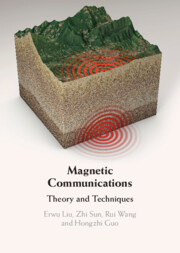87 results
CHARACTERISTIC POLYNOMIALS OF THE MATRICES WITH
 $(\,j,k)$-ENTRY
$(\,j,k)$-ENTRY  $q^{\,j\pm k}+t$
$q^{\,j\pm k}+t$
- Part of
-
- Journal:
- Bulletin of the Australian Mathematical Society , First View
- Published online by Cambridge University Press:
- 03 June 2024, pp. 1-10
-
- Article
- Export citation
Phylogenetic trends in TZ staining analysis of six deep dormancy seeds
-
- Journal:
- Seed Science Research , First View
- Published online by Cambridge University Press:
- 15 April 2024, pp. 1-13
-
- Article
-
- You have access
- Open access
- HTML
- Export citation
2 - Fundamentals of Magnetic Communications
- from Part I - Introduction and Properties of MI
-
- Book:
- Magnetic Communications
- Published online:
- 04 January 2024
- Print publication:
- 18 January 2024, pp 28-40
-
- Chapter
- Export citation
Notation
-
- Book:
- Magnetic Communications
- Published online:
- 04 January 2024
- Print publication:
- 18 January 2024, pp 214-214
-
- Chapter
- Export citation
7 - Magnetic Communication Networking Protocol Stacks
- from Part II - Theoretical Basis
-
- Book:
- Magnetic Communications
- Published online:
- 04 January 2024
- Print publication:
- 18 January 2024, pp 150-162
-
- Chapter
- Export citation
Frontmatter
-
- Book:
- Magnetic Communications
- Published online:
- 04 January 2024
- Print publication:
- 18 January 2024, pp i-iv
-
- Chapter
- Export citation
5 - MI Network Connectivity
- from Part II - Theoretical Basis
-
- Book:
- Magnetic Communications
- Published online:
- 04 January 2024
- Print publication:
- 18 January 2024, pp 87-105
-
- Chapter
- Export citation
1 - Introduction
- from Part I - Introduction and Properties of MI
-
- Book:
- Magnetic Communications
- Published online:
- 04 January 2024
- Print publication:
- 18 January 2024, pp 3-27
-
- Chapter
-
- You have access
- Export citation
3 - Magnetic Induction Antennas and Channel Characteristics
- from Part I - Introduction and Properties of MI
-
- Book:
- Magnetic Communications
- Published online:
- 04 January 2024
- Print publication:
- 18 January 2024, pp 41-62
-
- Chapter
- Export citation
Index
-
- Book:
- Magnetic Communications
- Published online:
- 04 January 2024
- Print publication:
- 18 January 2024, pp 215-217
-
- Chapter
- Export citation
Part III - Applications
-
- Book:
- Magnetic Communications
- Published online:
- 04 January 2024
- Print publication:
- 18 January 2024, pp 163-164
-
- Chapter
- Export citation
Preface
-
- Book:
- Magnetic Communications
- Published online:
- 04 January 2024
- Print publication:
- 18 January 2024, pp vii-viii
-
- Chapter
- Export citation
8 - Applications of Magnetic Communications Systems
- from Part III - Applications
-
- Book:
- Magnetic Communications
- Published online:
- 04 January 2024
- Print publication:
- 18 January 2024, pp 165-202
-
- Chapter
- Export citation
Part II - Theoretical Basis
-
- Book:
- Magnetic Communications
- Published online:
- 04 January 2024
- Print publication:
- 18 January 2024, pp 85-86
-
- Chapter
- Export citation
6 - MI Network Performance
- from Part II - Theoretical Basis
-
- Book:
- Magnetic Communications
- Published online:
- 04 January 2024
- Print publication:
- 18 January 2024, pp 106-149
-
- Chapter
- Export citation
References
-
- Book:
- Magnetic Communications
- Published online:
- 04 January 2024
- Print publication:
- 18 January 2024, pp 203-213
-
- Chapter
- Export citation
Part I - Introduction and Properties of MI
-
- Book:
- Magnetic Communications
- Published online:
- 04 January 2024
- Print publication:
- 18 January 2024, pp 1-2
-
- Chapter
- Export citation
Contents
-
- Book:
- Magnetic Communications
- Published online:
- 04 January 2024
- Print publication:
- 18 January 2024, pp v-vi
-
- Chapter
- Export citation
4 - Metamaterial-Enhanced Magnetic Communications
- from Part I - Introduction and Properties of MI
-
- Book:
- Magnetic Communications
- Published online:
- 04 January 2024
- Print publication:
- 18 January 2024, pp 63-84
-
- Chapter
- Export citation

Magnetic Communications
- Theory and Techniques
-
- Published online:
- 04 January 2024
- Print publication:
- 18 January 2024















